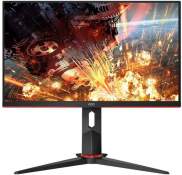How to choose the right monitor?
Choosing the right monitor for your needs can be a daunting task, with so many options available in the market. A monitor is an essential part of your computing setup, and it’s important to choose one that meets your specific needs. In this article, we’ll provide a detailed guide on what factors to consider when choosing a monitor, including size, resolution, refresh rate, panel type, and connectivity options. We’ll also touch on environmental factors like desk space, lighting, and budget considerations.
Panel type
Panel type is an important factor to consider, when buying a display. The three common types of panel technology used in monitors are Twisted Nematic (TN), In-Plane Switching (IPS), and Vertical Alignment (VA). TN panels are the most common and are famous for their swift response times, making them great for gaming. IPS panels offer better color accuracy and wider viewing angles, making them ideal for photo and video editing. VA panels offer the best contrast ratio and deep blacks, making them ideal for watching movies.
If you have a flexible budget then you can’t go wrong in invest in an OLED or PLS panel.
Size
Size is another important factor to consider when selecting a monitor. Larger screens are ideal for immersive experiences, such as gaming or watching movies, while smaller screens are more suitable for basic office use or web browsing. However, a larger screen will require more desk space, so it’s important to measure the area where the monitor will be placed to ensure that it will fit comfortably.
Resolution
Resolution is another important factor to consider. A higher resolution means more pixels. For instance, a 4K resolution (3840 x 2160 pixels) offers four times as many pixels as a 1080p resolution (1920 x 1080 pixels), providing a much clearer picture. However, it’s important to note that higher resolutions also require more powerful hardware to run smoothly.
Connectivity
Most monitors come with HDMI and DisplayPort inputs, which are the most common types of video connectors. If you have multiple devices to connect to your monitor, consider a monitor with multiple inputs or a built-in USB hub. You may also want to consider a monitor with built-in speakers or a headphone jack.
Refresh rate
Refresh rate refers to how many times per second the screen refreshes its image. A higher refresh rate means smoother and more fluid motion, which is crucial for gaming or fast-moving visuals. The most common refresh rate for monitors is 60Hz, but some gaming monitors can have a refresh rate of 144Hz or even 240Hz (Top of the line gaming monitors also offer up to 360Hz refresh rate ).
Environmental Factors
Environmental factors should also be taken into account when selecting a monitor. Lighting in your workspace can have a significant impact on the performance of your monitor. For example, if you have a bright room with lots of natural light, a monitor with a matte screen may be better to reduce glare and reflections or buy a monitor with an anti-glare screen. It’s also important to consider the amount of desk space available to you, as a larger monitor will require more space. If you have limited desk space, consider a monitor with a smaller footprint or one that can be mounted on a wall.
Budget
Lastly, budget is probably the most important consideration when selecting a monitor. Monitors can range in price from a few hundred dollars to several thousand dollars, depending on their features and specifications. Before making a purchase, determine what features are most important to you and what you can afford. If you’re a gamer or a professional in need of high-end specs, you may need to spend more to get the features you require. However, if you’re just looking for a basic monitor for web browsing or office work, you may be able to find a more affordable option.
In conclusion
In conclusion, choosing the right monitor requires careful consideration of various factors, including size, resolution, refresh rate, panel type, and connectivity options. It’s also important to take into account environmental factors like desk space and lighting, as well as your budget. With these factors in mind, you can make an informed decision and choose a monitor that meets your specific needs, providing an optimal viewing experience.
If you need help with set up your new monitor then the following article can help you in doing so:
If you don’t want to burn a hole in your pocket while buying a new monitor, then the article below can help you in finding them:

